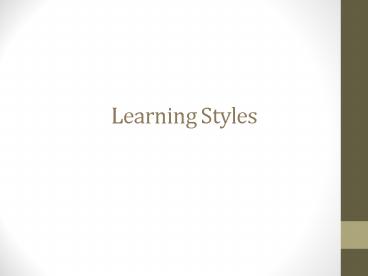Learning Styles - PowerPoint PPT Presentation
1 / 16
Title:
Learning Styles
Description:
... -pictures -flow charts -diagrams Verbal learners prefer: ... and who perceive and process information abstractly and actively respectively. prefer readings, ... – PowerPoint PPT presentation
Number of Views:198
Avg rating:3.0/5.0
Title: Learning Styles
1
Learning Styles
2
Objectives
- Students should be able to
- define the term learning styles.
- recognize different learning styles.
- Recognize the importance of knowing learning
styles in teaching.
3
The definition of the term Style
- Styles are those general characteristics of
intellectual functioning (and personality type,
as well) that pertain to you as an individual,
and that differentiate you from someone else.
4
A number of learning styles have been identified
and studied over years.
5
We will discuss two general types of learning
styles
- 1- Cognitive learning styles
- 2- Learning styles ( discussed by a researcher
called kolb in 1984)
6
Cognitive Learning Styles
- Definition
- The way we learn things in general and the way we
attack a problem seem to hinge on a link between
personality and cognition this link is referred
to as cognitive style.
Cognitive Style
Personality
Cognition
7
Cognitive learning Styles
- 1- Left and Right brain functioning
- 2- Field Independence vs. Field dependence
- 3- Visual vs. Verbal
- 4- Sensory vs. Intuitive
8
1- Left and Right- brain functioning
- The left hemisphere is associated with
- -logical thought
- -analytical thought
- -with mathematical and linear processing of
information. - The right hemisphere perceives
- Visual -auditory
- It is associated with holistic processing and
emotional information.
9
Left
Right Logical
Visual Analytical
AuditoryMathematical
emotional Linear thinking
Holistic thinking
10
2- Field Independence vs. Field
dependence
- Field independent learners are able to perceive
parts from a whole (i.e. they see only parts but
not their relationship to the whole). - Field dependent learners are able to perceive the
whole picture (i.e. they always tend to have a
general or a larger view) .
11
3- Visual vs. Verbal
- Visual learners prefer information presented
visually with - -pictures
- -flow charts
- -diagrams
- Verbal learners prefer
- -oral explanation
- -written explanation
12
4- Sensory vs. Intuitive
- Sensory learners prefer
- facts
- data
- details
- Intuitive learners prefer
- imagination
- dont like details
13
Learning styles ( discussed by a researcher
called kolb in 1984)
- Divergents(feeling and watching) who need to be
personally involved in the task, who perceive
information in concrete terms and who reflect on
it. - Sensitive, perform better in brainstorming ,work
in groups, listen with an open mind and receive
personal feedback. - Convergers (doing and thinking) who prefer
detailed steps in learning who perceive
information abstractly and who reflect on it. - Solitary, do not like group-work find practical
uses for ideas and theories. like to solve
problems Analytic learners Independent
14
Learning styles ( discussed by a researcher
called kolb in 1984)
- Assimilators (watching and thinking) who thrive
on problem-solving activities, and who perceive
and process information abstractly and actively
respectively. - prefer readings, lectures, exploring analytical
models, and having time to think things through,
less focused on people and more interested in
ideas and abstract concepts. - Accommodators (doing and feeling) who enjoy
taking risks, who thrive on flexibility in
learning activities, and who process information
actively. - 'hands-on', and relies on intuition rather than
logic, rely on others for information than carry
out their own analysis.
15
Conclusion
- In conclusion, we have discussed two general
types of learning styles cognitive learning
styles and learning styles introduced by Kolb in
1984. An awareness of these styles will help
teachers to perceive some wide-ranging individual
differences in their learners. Not all learners
are alike. Thus, teachers need to recognize and
understand different learning styles in order to
provide them with the best possible opportunities
for learning. Moreover, learning styles can be
used to predict what kind of instructional
methods would be most effective for a certain
group of learners.
16
References
- Cohen, L., Manion, L., Morrison, K. (2004). A
guide to teaching practice (5th ed.).
RoutledgeFalmer - Brown, H. (2000). Principles of language learning
and teaching (4th ed.). Addison Wesley Longman,
Inc.































